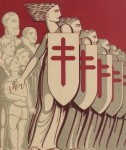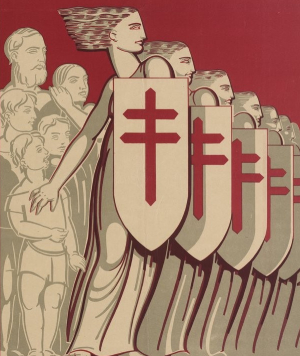
 A stamp against tuberculosis, 1930, Gallica. As early as the years 1930-50, tuberculosis patient associations became significant political actors.
A stamp against tuberculosis, 1930, Gallica. As early as the years 1930-50, tuberculosis patient associations became significant political actors.
Uniquely intersecting the medical, political and historical spheres, patient associations, which bring together within a legal framework people whose aim is other than sharing profits, have, seen through the prism of illness, a long and rich history. This history can be traced back to the Ancien Régime’s trade guilds and their benevolent funds. These funds, which endured throughout the 19th century, the bans imposed by the Allarde Decree and Le Chapelier Law notwithstanding, are at the root of trade unionism and mutualism. They bespeak illness’ social dimension and its age-old link with labour. The 1884 law on the right to organise and that of 1901 on freedom of association confirmed this deep interwovenness. Accordingly, the 30s to 50s tuberculosis environment yielded associations directly or indirectly connected with labour unions, to wit the Fédération Nationale des Tuberculeux (FNT) and the Confédération Générale du Travail (CGT). Access to health is first and foremost an economic issue and the presence of the trade unions in the social security joint management system to this day bears out this question’s enduring actuality.
However, the sick organised for other reasons as well. The carnage of the Great War and the frontline’s parlous living conditions left horrific sequels in the population. Gassed, defaced, amputee, phthisic… The inflicted wounds joined in a common fate sufferers with a shared history. Great associations like the Union des Blessés de la Face (face) or the FNBP - Fédération Nationale des Blessés du Poumon (chest), both founded in 1921 epitomize the movement that built up at the time. TB in particular inspired a flood of associative developments. Spurred on by the Rockefeller Foundation, a mighty US philanthropic structure, this efflorescence helped, as from 1917, bolster up sanatorial facilities as yet under-developed in France. Such associations could muster hundreds of thousands of members, enjoying contacts in the higher reaches of government, capable of steering legal and regulatory decisions and enjoying substantial financial leverage. Thus, between 1931 and 1933 the FNBP had a huge healthcare development built at Salignac, the Clairvive sanatorial resort.
These associations’ institutional weight was such that, at the Liberation, the Ministry for Health, created a patient associations advisory board. However, by the 60s, the development of ambulatory care for sensitive conditions dealt a heavy blow to these associations. With the collapse of the sanatorium model, the TB associations redirected their action towards the disabled and their professional rehabilitation – which did not stem the membership outflow: 200,000 members strong in 1953, the FNBP was down to 3000 in 1966.
A highpoint for TB patient associations, the 50s also witnessed the growth of other associations such as the AFM - Association Française de lutte contre les Myopathies (Neuromuscular disease) created in 1958. Whereas the fast economic growth of the Trente Glorieuses (1945-75) and contemporary developments in hospital care may have overshadowed the associative model, from the 80s on, associations were reinvigorated by the HIV-AIDS crisis which reasserted patient groups’ clout and place in the public debate. Impelled by therapeutic silence and sluggish research, the movement, which by and by affirmed the homosexual identity, was significant. AIDES, Act-up et al. intended, via media, socio-political and therapeutic action, to address the illness’ full implications. At the same time, the 80s also introduced a major fundraising TV programme, the Téléthon whose enduring success makes it the backer of important research projects.
Halfway between private suffering and collective healthcare management stand a world of intermediaries. Far from being silent actors, associations have spoken up and weighed in on political debates and therapeutic action alike.
Read more in the dictionnary : The Blind - Neurodiversity
Read the paper in french : Associations de patients
Références :
Bachelot Pierre, « L’influence politique d’une association de malades au cours des années 1945-1955 au travers de son mensuel Vers la Vie », in Faure O., Guillemain H. (dir) Pour en finir avec les médecines parallèles, Histoire, Médecine et Santé.(14) Toulouse, 2019. pp. 103-120.
Barbot Janine, Les malades en mouvements : la médecine et la science à l’épreuve du sida, Paris, Balland, 2002.
To quote this paper : Pierre Bachelot, "Patient associations" in Hervé Guillemain (ed.), DicoPolHiS, Le Mans Université, 2021.